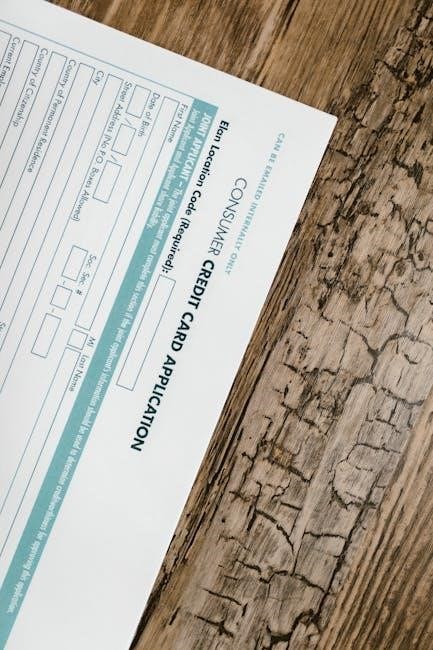Overview of the Tenancy Application Process
The tenancy application process involves a landlord and tenant agreeing on terms, with the landlord preparing a written agreement for every tenancy. This process includes the landlord screening and selecting tenants based on factors such as income and employment history. The landlord must complete all of Section A of the application, which includes an offer to rent. The remainder of the form is to be completed by the landlord interviewing the applicant. The application process is governed by the Residential Tenancy Act, SBC 2002, c. 78, which outlines the rules and regulations for tenancies in British Columbia. The landlord and tenant must both sign the agreement, and it is recommended that the tenant keep a copy of the signed agreement for their records. The application process is an important step in establishing a tenancy.
Importance of a Written Tenancy Agreement
A written tenancy agreement is a crucial document that outlines the terms and conditions of a tenancy, protecting both the landlord and tenant. It provides clarity on the rights and responsibilities of both parties, helping to prevent disputes and misunderstandings. The agreement should include essential details such as rent, lease duration, and property maintenance. Having a written agreement in place helps to establish a positive and respectful landlord-tenant relationship. It also serves as a reference point for resolving any issues that may arise during the tenancy. A written tenancy agreement is a requirement under the Residential Tenancy Act, and landlords must prepare one for every tenancy. This agreement is a vital component of the tenancy application process, providing a foundation for a successful and harmonious tenancy. The agreement must be signed by both parties, and a copy should be kept by each for their records.

Components of a Tenancy Application Form

Includes applicant information, property description, and rental accommodation details, with sections for landlord and applicant to complete, using the Residential Tenancy Act guidelines and regulations carefully always.
Required Information for Applicants
The free tenant application form BC requires applicants to provide their full legal names, birth dates, primary contact numbers, and email addresses. Applicants must also input their current residence address, including city, along with the start and end dates of their present tenancy. This information is necessary for landlords to assess the applicant’s suitability as a tenant. The application form may also request additional information, such as employment history and income details, to help landlords evaluate the applicant’s financial stability. Furthermore, applicants may be required to provide references or undergo a credit check as part of the application process. By providing accurate and complete information, applicants can increase their chances of a successful tenancy application. The required information for applicants is outlined in the Residential Tenancy Act, which governs the rental housing market in British Columbia.
Property Description and Rental Accommodation
The property description and rental accommodation section of the free tenant application form BC is crucial in identifying the specific rental unit being applied for. This section typically requires the applicant to enter the property description, including the address, unit number, and type of accommodation. The applicant must also specify the type of rental accommodation they are applying for, such as a house, apartment, or condo. Additionally, the form may ask for details about the rental unit, including the number of bedrooms and bathrooms, and any amenities or services included in the rent. By providing accurate information about the property and rental accommodation, applicants can ensure that their application is processed correctly and efficiently. The property description and rental accommodation details are essential in creating a valid and binding tenancy agreement. This information helps to prevent disputes and ensures a smooth tenancy.

Accessing Free Tenant Application Forms
Accessing free tenant application forms is available online through official websites and resources, providing easy and convenient access to required forms and documents instantly always.
Availability of Free Forms on the Province of BC’s Website
The Province of BC’s website offers a range of free forms and resources for tenants and landlords, including the BC Residential Tenancy Agreement. This agreement is a contract between a landlord and tenant, outlining the terms and conditions of the tenancy. The website provides easy access to these forms, allowing users to download and print them as needed. The forms are available in a variety of formats, including PDF and Word documents. The Province of BC’s website is a reliable source for free tenant application forms, providing users with the necessary documents to establish a tenancy. The website is regularly updated to reflect changes in the law and regulations, ensuring that users have access to the most current information and forms. This makes it a valuable resource for both tenants and landlords in BC.
Additional Resources and Forms
Additional resources and forms are available to support the free tenant application form BC, including guides for tenants and landlords, and calculators for rent and security deposits. The Province of BC’s website provides a range of resources, including FAQs and policy guidelines, to help users navigate the tenancy process. Other organizations, such as the Residential Tenancy Branch, also offer resources and forms to support tenants and landlords. These resources can help users understand their rights and responsibilities, and provide guidance on completing the tenant application form. The resources and forms are designed to be user-friendly and accessible, making it easier for tenants and landlords to manage their tenancies. By utilizing these additional resources and forms, users can ensure a smooth and successful tenancy application process in BC. The resources are regularly updated to reflect changes in the law and regulations.

Submission and Processing of Applications
Submission and processing of applications involves checking status and processing times online through the official website with ease and convenience always available to users instantly.
Checking Application Status and Processing Times
Checking application status and processing times is a crucial step in the tenant application process. Applicants can check their application status online through the official website. The website provides an easy-to-use interface for applicants to track their application progress. Additionally, applicants can also find information on processing times, which can vary depending on the complexity of the application. It is essential for applicants to regularly check their application status to ensure that their application is being processed efficiently. The official website also provides resources and guides to help applicants navigate the application process. By checking application status and processing times, applicants can stay informed and plan accordingly. This helps to reduce uncertainty and anxiety, allowing applicants to focus on other important aspects of their tenancy application. Overall, checking application status is a vital part of the tenant application process.
Paying Fees and Determining Eligibility
Paying fees and determining eligibility are important steps in the tenant application process. Applicants may need to pay fees associated with their application, such as processing fees or credit check fees. The official website provides information on the required fees and payment methods. To determine eligibility, applicants must meet certain criteria, such as income requirements or rental history. The landlord or property manager will review the application and supporting documents to determine eligibility. Applicants can also find information on eligibility criteria and required documents on the official website. By understanding the fees and eligibility criteria, applicants can better navigate the application process and increase their chances of a successful application. The website also provides resources and guides to help applicants understand the eligibility criteria and required fees, making the process more transparent and efficient.
